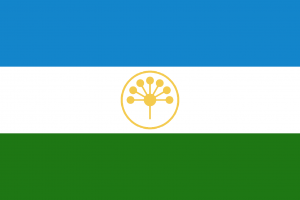Language/Bashkir/Grammar/Basic-Adjectives
| ◀️ Relationships — Previous Lesson | Next Lesson — Comparative and Superlative ▶️ |
Introduction[edit | edit source]
Welcome to the lesson on basic adjectives in the Bashkir language! Adjectives are an essential part of any language, as they allow us to describe and express the qualities of people, places, and things. In this lesson, we will explore the most common Bashkir adjectives and learn how to use them in sentences. Understanding adjectives will greatly enhance your ability to communicate in Bashkir and provide you with a solid foundation for further language learning.
Throughout this lesson, we will provide clear explanations, numerous examples, and engaging practice exercises to help you grasp the concepts and apply them in real-life situations. We will also explore any regional variations in the usage of adjectives in Bashkir, as well as share interesting cultural facts that relate to this topic. So let's dive in and start exploring the world of adjectives in the Bashkir language!
Basic Adjectives[edit | edit source]
Adjectives in Bashkir are used to describe the qualities or attributes of nouns. They can be used to indicate the size, color, shape, age, origin, or any other characteristic of the noun they modify. In Bashkir, adjectives agree with the noun in case, number, and gender. This means that the adjective changes its form depending on the noun it accompanies.
Let's start by learning some basic adjectives in Bashkir:
| Bashkir | Pronunciation | English Translation |
|---|---|---|
| ҙур | źur | big |
| кескәй | keskäy | small |
| яҡшы | yakshı | good |
| яман | yaman | bad |
| аҡ | aq | white |
| ҡара | qara | black |
| һары | harı | yellow |
| зәңгәр | zäŋgär | (light) blue |
In the table above, you can see the Bashkir adjectives along with their pronunciation and English translations. It's important to familiarize yourself with the pronunciation of these adjectives to ensure accurate communication in Bashkir.
Now, let's see how these adjectives can be used in sentences:
- Бесәй ҙур. (Besäy źur.) - The cat is big. - Өй кескәй. (Öy keskäy.) - The house is small. - Был китап яҡшы. (Bıl kitap yakshı.) - It's a good book. - Ул яман кеше. (Ul yaman keshe.) - She/he is a bad person. - Уның күҙе һоро. (Unıŋ küźe horo.) - He/she has white eyes. - Уның күҙе ҡара. (Unıŋ küźe qara.) - She/he has black eyes. - Ҡояш һары. (Qoyaş harı.) - The sun is yellow. - Күк зәңгәр. (Kük zäŋgär.) - The sky is (light) blue.
As you can see from the examples, the adjectives agree with the noun in case, number, and gender. This agreement is necessary to maintain grammatical correctness in Bashkir sentences.
Cultural Insight[edit | edit source]
In Bashkir culture, the use of adjectives is not only important for communication but also reflects the values and aesthetics of the community. Bashkir people have a rich tradition of poetry and storytelling, where the use of vivid and descriptive adjectives is highly valued. Adjectives are often used to create imagery and evoke emotions in the listener or reader.
Additionally, regional variations in the usage of adjectives may exist within the Bashkir language. These variations can be influenced by factors such as dialects, geographical location, and cultural practices. For example, in some regions, certain adjectives may be more commonly used or have slightly different meanings compared to other regions. Exploring these variations can provide valuable insights into the cultural diversity within the Bashkir-speaking community.
Practice Exercises[edit | edit source]
Now, let's practice using the basic adjectives we have learned in this lesson. Complete the following exercises by choosing the appropriate adjective to complete each sentence:
1. Был бесәй __. (aҡ / кескәй / яҡшы / ҡара) - The cat is small. 2. Был китап __. (ҙур / яман / һары / күк) - The book is good. 3. Уның күҙҙәре __. (күк / ҡара / һары / аҡ) - She/he has blue eyes. 4. Ул __ кеше. (күк / аҡ / ҡара / яҡшы) - He/she is a bad person.
Solution: 1. Был бесәй кескәй. (Bıl besäy keskäy.) 2. Был китап яҡшы. (Bıl kitap yakşı.) 3. Уның күҙҙәре күк. (Unıŋ küźźäre kük.) 4. Ул яман кеше. (Ul yaman keşe.)
Explanation: 1. The adjective "keskäy" (small) is used to describe the noun "besäy" (cat) in the sentence. 2. The adjective "yakşı" (good) is used to describe the noun "kitap" (book) in the sentence. 3. The adjective "kük" (blue) is used to describe the noun "küźźär" (eyes) in the sentence. 4. The adjective "yaman" (bad) is used to describe the noun "keşe" (person) in the sentence.
Congratulations! You have successfully completed the practice exercises. By practicing the usage of adjectives in context, you are reinforcing your understanding and improving your ability to construct meaningful sentences in Bashkir.
Conclusion[edit | edit source]
In this lesson, we have explored the basics of adjectives in the Bashkir language. We have learned some common adjectives and how to use them in sentences. Adjectives play a crucial role in providing details and descriptions in Bashkir communication, allowing us to express our thoughts and convey meaning effectively. By mastering the usage of adjectives, you are taking a significant step towards becoming fluent in Bashkir.
Remember to practice using adjectives in different contexts and continue building your vocabulary. In the next lesson, we will delve deeper into the world of adjectives and explore comparative and superlative forms. So keep up the great work and continue your language learning journey with enthusiasm!
Sources[edit | edit source]
Other Lessons[edit | edit source]
- Common Prepositions
- Pronouns
- Plural Nouns
- Future Tense
- Conjunctions
- Questions
- Conditional Mood
- Personal Pronouns
- Give your Opinion
- Past Tense
| ◀️ Relationships — Previous Lesson | Next Lesson — Comparative and Superlative ▶️ |

